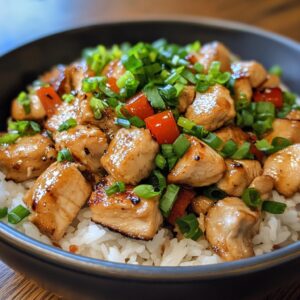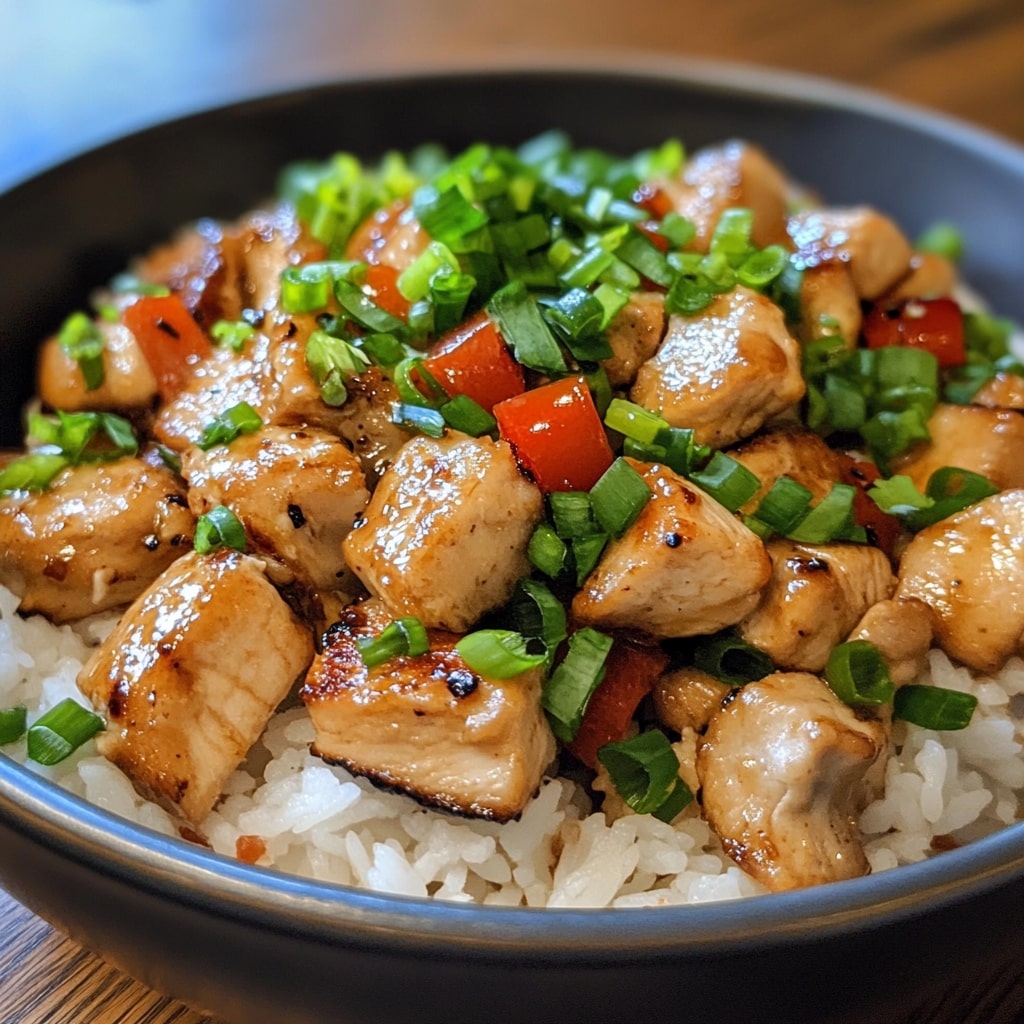Introduction:
Hibachi Chicken is a popular dish known for its bold flavors and savory marinade, often prepared on a high-heat grill or stovetop. The chicken is typically seasoned with a blend of soy sauce, ginger, garlic, and other savory ingredients, then grilled or seared to perfection. The dish is often served with vegetables, fried rice, or noodles, and is a favorite in Japanese steakhouses and hibachi restaurants worldwide. The smoky, caramelized exterior of the chicken combined with its juicy and tender interior makes it a crowd-pleasing meal. Hibachi cooking, known for its theatrical presentation, adds a fun and interactive element to the meal, whether made at home or enjoyed at a hibachi grill restaurant. The simplicity of the ingredients and the quick cooking method allow the flavors to shine, making it a favorite for both casual and special occasions.
The History of Hibachi Chicken:
The word “hibachi” originally referred to a traditional Japanese heating device, a portable charcoal grill, used for cooking food over an open flame. Over time, the term hibachi became synonymous with a style of cooking, particularly in Japanese steakhouses, where ingredients are grilled on a flat surface or grill in front of guests. The hibachi cooking style is known for its high-heat searing method, which locks in the juices and flavors of the meat, creating a crispy exterior while keeping the inside tender. Hibachi chicken, along with other hibachi dishes such as shrimp, steak, and vegetables, became popular in the United States in the mid-20th century with the rise of Japanese-themed restaurants. The showmanship involved in preparing the food, where chefs perform tricks and prepare the meal right in front of diners, contributed to its widespread appeal. Hibachi chicken, with its savory marinade and quick cooking method, remains a staple in many restaurants and home kitchens, offering an easy way to enjoy Japanese-inspired cuisine.
Ingredients Breakdown:
For Hibachi Chicken, you’ll need boneless, skinless chicken breasts or thighs, which are tender and quick to cook on high heat. The marinade typically includes soy sauce, ginger, garlic, sesame oil, and rice vinegar, which together create a savory and slightly tangy flavor profile. To balance the flavors, brown sugar is often used, adding a hint of sweetness to complement the salty soy sauce. Optional ingredients such as green onions and sesame seeds can be added for garnish, providing extra flavor and texture. For the side, hibachi chicken is commonly served with sautéed vegetables like zucchini, mushrooms, and onions, along with fried rice or noodles, making the meal complete. The simple yet vibrant ingredients make hibachi chicken a flavorful dish that’s easy to prepare and sure to satisfy.
Step-by-Step Recipe:
- Marinate the Chicken: In a bowl, combine 1/4 cup soy sauce, 1 tablespoon sesame oil, 1 tablespoon rice vinegar, 1 tablespoon brown sugar, 1 teaspoon grated ginger, and 2 cloves minced garlic. Whisk the ingredients together until the sugar dissolves. Add the chicken breasts or thighs to the marinade, ensuring the pieces are fully coated. Cover and refrigerate for at least 30 minutes, or up to 2 hours, to allow the flavors to infuse.
- Prepare the Grill or Skillet: Preheat a grill, grill pan, or skillet over medium-high heat. Lightly grease with oil to prevent sticking.
- Cook the Chicken: Remove the chicken from the marinade, letting any excess liquid drip off. Place the chicken on the preheated grill or skillet and cook for 4-5 minutes per side, or until the chicken reaches an internal temperature of 165°F and is nicely seared on the outside. If using a grill, you can rotate the chicken to create crosshatch grill marks for a more authentic hibachi look.
- Sauté the Vegetables (Optional): While the chicken is cooking, sauté vegetables like zucchini, mushrooms, and onions in a separate pan with a bit of sesame oil or butter, cooking until tender.
- Serve: Once the chicken is cooked, remove it from the grill or skillet and let it rest for a few minutes before slicing it into strips. Serve the chicken with sautéed vegetables, fried rice, or noodles. Garnish with chopped green onions and a sprinkle of sesame seeds.
Tips for the Perfect Hibachi Chicken:
For the most flavorful hibachi chicken, be sure to marinate the chicken for at least 30 minutes, but longer if possible, to allow the flavors to fully penetrate the meat. Use boneless, skinless chicken thighs for a juicier result, or chicken breasts for a leaner option. When cooking the chicken, ensure that the grill or skillet is preheated to a high temperature to achieve that perfect sear and caramelized crust. If you’re using a grill, avoid flipping the chicken too frequently, as it can disrupt the sear and prevent it from developing a nice crust. For extra flavor, brush the chicken with a little of the marinade as it cooks, but make sure to discard any leftover marinade that has come into contact with raw chicken. If you prefer a smoky flavor, consider using a charcoal grill for an authentic hibachi experience.
Variations and Customizations:
Hibachi chicken can easily be customized to suit your preferences or dietary needs. For a spicier version, you can add chili flakes or a splash of sriracha to the marinade, creating a nice balance of heat and savory flavors. If you’re looking for a low-carb version, consider serving the chicken with a cauliflower rice substitute instead of traditional fried rice. To make the dish vegetarian, swap the chicken for tofu or tempeh, which can be marinated and cooked using the same method. For a sweeter version, you can add honey or maple syrup to the marinade instead of brown sugar. If you’re looking to add more vegetables to the dish, try incorporating bell peppers, carrots, or snap peas into the sautéed vegetable mix. The flexibility of hibachi chicken allows for a wide range of variations to suit different tastes and dietary restrictions.
Health Considerations and Nutritional Value:
Hibachi chicken can be a nutritious and balanced meal, offering a good source of protein from the chicken, and when paired with sautéed vegetables, it provides additional vitamins, minerals, and fiber. To make the dish healthier, opt for boneless, skinless chicken breasts instead of thighs, which are lower in fat. For a lower-sodium option, use low-sodium soy sauce and reduce the amount of salt in the marinade. The dish is also easily adaptable for those following gluten-free or dairy-free diets—just be sure to use gluten-free soy sauce and substitute the sesame oil if needed. If you’re aiming to reduce calories, skip the fried rice and serve the chicken with a side of steamed vegetables or a fresh salad. The inclusion of healthy fats from the sesame oil and antioxidants from the garlic and ginger adds to the overall nutritional value of the dish, making it a satisfying and wholesome meal.
FAQ:
Q: Can I make the hibachi chicken ahead of time?
A: Yes, you can marinate the chicken ahead of time and cook it when you’re ready. The chicken can also be cooked in advance and reheated in a skillet or microwave.
Q: Can I use chicken thighs instead of chicken breasts?
A: Absolutely! Chicken thighs are a great option and tend to be juicier and more flavorful than chicken breasts.
Q: Can I add more vegetables to the dish?
A: Yes! Feel free to add your favorite vegetables, such as bell peppers, broccoli, or snap peas, for added color and nutrients.
Q: Can I make the dish spicier?
A: Yes, if you like spice, you can add chili flakes, sriracha, or a small amount of hot sauce to the marinade.

Hibachi Chicken
Ingredients
For the Yum Yum Sauce
- 1 cup mayonnaise
- 1 tablespoon melted butter
- 1/2 tablespoon Sriracha sauce or ketchup
- 1/4 teaspoon paprika
- 1 teaspoon garlic powder
- 1 teaspoon onion powder
- 1/8 teaspoon cayenne pepper
- 1 tablespoon sugar
- 1 tablespoon mirin optional
- 1-2 tablespoons water
For the Chicken
- 1.5 lbs boneless skinless chicken breasts, cut into bite-sized pieces
- 2 tablespoons butter divided
- 2 tablespoons sesame oil divided
- 3 cloves garlic minced
- 1/4 cup soy sauce
- 1 tablespoon brown sugar
- Juice of 1/2 lemon
- Salt and pepper to taste
For the Vegetables
- 1 cup zucchini sliced into half-moons
- 1 cup mushrooms sliced
- 1 cup onion sliced
- 1 cup carrots julienned
- 1 tablespoon soy sauce
- 1 tablespoon sesame oil
- Salt and pepper to taste
- For the Fried Rice
- 3 cups cooked white rice preferably day-old
- 2 eggs beaten
- 1 cup frozen peas and carrots thawed
- 3 tablespoons soy sauce
- 2 tablespoons sesame oil
- 2 tablespoons butter
- 3 cloves garlic minced
- 1/4 cup green onions chopped
- Salt and pepper to taste
Instructions
- Combine all the ingredients for the sauce in a bowl. Stir until smooth and set aside. For the best flavor, refrigerate the sauce for at least an hour before serving.
- Heat a wok or large skillet over medium-high heat. Add 1 tablespoon of butter and 1 tablespoon of sesame oil, allowing the butter to melt and bubble.
- Add the chicken pieces to the hot skillet. Season with salt and pepper, cooking and turning occasionally until the chicken is browned on all sides and fully cooked, about 5-8 minutes.
- Reduce the heat to medium. Add the minced garlic and cook for about 30 seconds until fragrant. Then, pour in the soy sauce, brown sugar, and the remaining butter. Stir to coat the chicken evenly.
- Squeeze the juice of half a lemon over the chicken and stir once more. Let the mixture simmer for 2-3 minutes until the sauce thickens and coats the chicken.
- In a separate skillet or the same wok after cooking the chicken, heat 1 tablespoon of sesame oil over medium-high heat. Add the zucchini, mushrooms, onion, and carrots. Season with salt and pepper. Stir-fry for about 5-7 minutes until the vegetables are tender yet still crisp. Add 1 tablespoon of soy sauce and stir to coat the vegetables evenly. Cook for another 1-2 minutes.
- In the same skillet or wok, push the vegetables to one side and add the beaten eggs. Scramble until fully cooked, then mix them with the vegetables. Add the cooked rice, thawed peas, and carrots to the skillet, stirring well to combine.
- Add the soy sauce, sesame oil, and butter. Stir to coat the rice evenly. Cook for another 5-7 minutes, stirring occasionally, until the rice is heated through. Add the minced garlic and chopped green onions. Stir and cook for an additional 2-3 minutes.
- Serve the hibachi chicken with the cooked vegetables and fried rice. For extra flavor, drizzle with the remaining sesame oil. Pair the dish with the Yum Yum Sauce for dipping.

